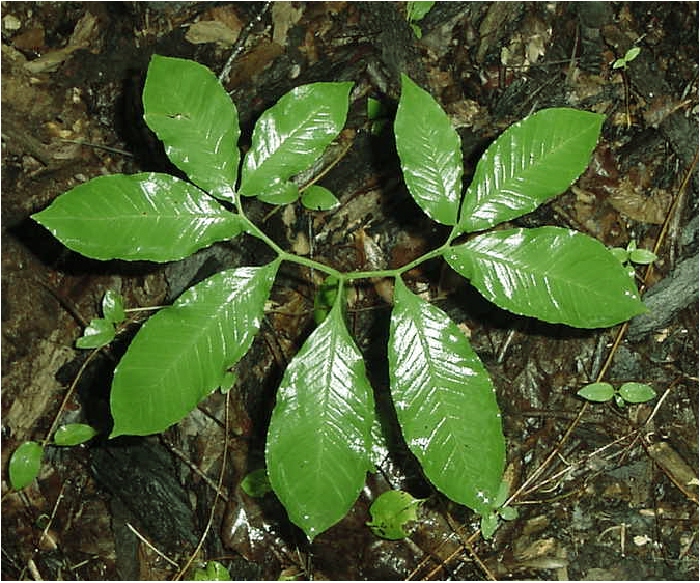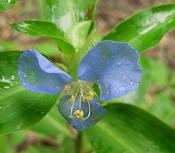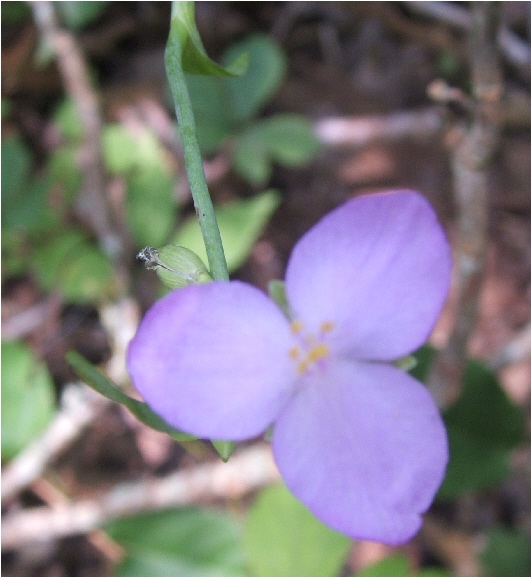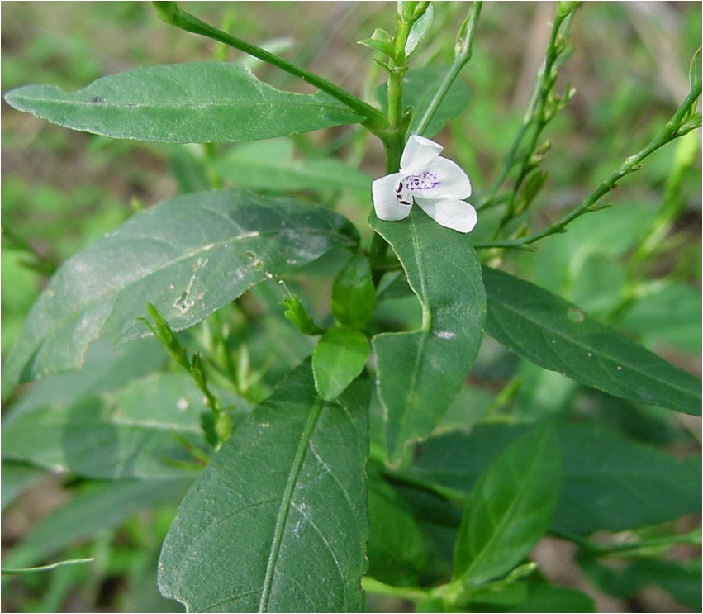|
Family Araceae
|
 |
Green Dragon - Arisaema dracontium
A single horseshoe-shaped leaf, with 7-15 leaflets radiating out. The hooded flower supposedly looks like a dragon with a long tongue. Tight cluster of
red fruit. Found commonly in the flood plain area of Acadiana Nature Park. The root may be edible, but only after drying and aging for months. Fresh
plants should not be ingested. The Chinese have historically used related species as a local anesthetic and for treating epilepsy and paralysis. The
fruit and leaves are sometimes eaten by wildlife, such as wood thrushes. |
|
Family Bromeliaceae
|
| |
Spanish Moss - Tillandsia usneoides
This epiphytic plant gathers its nutrients and water from the air around it, thus making its very susceptible to environmental pollution. It lives on
the shady branches of many trees or wires and is widely distributed in the southeastern region, from swamp to upland. The flowers are about 1/4 inch in
diameter and are emerald green with three petals. As a bromeliad, this plant is not really a moss but rather related to the pineapple. Has been used for
making pillows and mattresses, but it contains red bugs.
|
|
Family Commelinaceae
|
 |
Broad-leaf Dayflower - Commelina virginica
This perennial species is easily identified by its flowers, consisting of two larger blue petals and a third smaller petal in a terminal cluster,
blooming all summer and fall. They prefer open, sandy habitat. Its seeds are eaten by Mourning Doves, Quail, and several kinds of songbirds. In China,
where it originates, a tea is used to treat sore throats, or for its cooling, detoxifying, or diuretic properties.
|
 |
Spiderwort - Tradescantia ohioensis
These less-than-one-inch purple flowers are found blooming from March until late spring. Here in the Nature Station, these perennial herbs are found in
sunny, open areas, mixed in with grasses, sedges, and other herbaceous plants. American Indians used the root in a tea to treat kidney and stomach and
as a laxative. They would also make a poultice by smashing the leaves to treat insect bites or stings. |
|
Family Cyperaceae
|
| |
Caric Sedge - Carex sp.
Several species, as yet undetermined. There are 125 species in this area, and it is very difficult to tell them apart. The seeds are an important food
source for wildlife, including waterfowl like teals and rails, and songbirds like sparrows, cardinals, and finches. Sedges also provide dense cover for
nesting. |
|
Family Iridaceae
|
| |
Short-stem Iris - Iris brevicaulis
The stem is about two feet tall, with a zig-zag growing pattern. Grows in low wet areas, with deep blue to purple flowers. Slender rhizomes propagate
the species. |
| |
Blue-eyed Grass - Sisyrinchium sp.
A couple of species undetermined. A native grass making small blue flowers in the spring. Found on the lawn in the prairie terrace area of Acadiana Nature
Park. American Indians made root tea for diarrhea and leaf tea for stomachaches.
|
|
Family Lemnaceae
|
| |
Duckweed - Lemna aequinoctialis
An extremely aggressive aquatic plant, lacking any distinct stem or leaves. Its masses will fill water surfaces in the open or shade and can potentially
chokes out other aquatic life. It covers the waterways in the Acadiana Nature Park in the summer. It fills an important role in our waterways by providing
food for waterfowl and small mammals.
|
|
Family Liliaceae
|
| |
Canada Onion - Allium canadense
A perennial bulbous plant with onion odor. Clusters of small white flowers in spring. The bulbs and young leaves can be boiled and eaten, with the liquid
used to make soup. The top bulbs can be pickled, but large amounts of this plant can be harmful, particularly for livestock. These onions are very common,
especially along roadsides, in open fields, and along edges. |
| |
Spider Lily - Hymenocallis liriosome (previously H. occidentalis in Family Amaryllidaceae)
This distinctive spring-blooming large white flower has thin, spidery, petals surrounding the stamens, which are joined by a membrane, forming a cup, all
on a long floral tube. Grows in damp, shady areas, like in the flood plain. |
| |
Crow Poison or False Garlic - Nothoscordum bivalve
It is common in fields, open pastures, and roadsides. This plant has no onion or garlic odor - an important distinction, since the flowers look very
similar to the edible Canada Onion. Blooms from late February until April, sometimes in the fall as well.
|
|
Family Orchidaceae
|
| |
Upland Ladies' Tresses - Spiranthes vernalis
The tiny, white, downward-arching flowers of this orchid will bloom in a spiral formation, with the lower blooms most mature. It prefers moist places,
coastal salt marshes, floodplains, and occurs occasionally in the coastal prairie. Used by American Indians as a diuretic and aphrodisiac.
|
|
Family Acanthaceae
|
| |
Lance-leaved Water Willow - Justicia ovate
Summer-blooming emergent water plant with purple-spotted white flowers. The shape of the leaves give this perennial flower its name. Found in the
wettest spots on the floodplain. |
 |
Water-willow - Justicia Americana
Named for its opposite willow-shaped leaves and because it can grow in standing water. White flowers spotted with purple bloom from June through October.
|
| |
Wild Petunia - Ruellia caroliniensis
A very pretty, rather dainty and given to fainting spells: a favorite among the nature station staff. With opposite leaves, this light purple
trumpet-shaped flower will show its face in our gravel driveway and under the boardwalk in mid-spring. In general, this species prefers to grow
in open forests and dry upland soils.
|
|
Family Apocynaceae
|
| |
Blue Star - Amsonia tabernaemontana
Perennial clumping flowers that look like their name, grows up to three feet tall with lance-shaped leaves and is found commonly in rich deciduous
woods or wet sites in alluvial soils such as ours here at the Nature Station. |